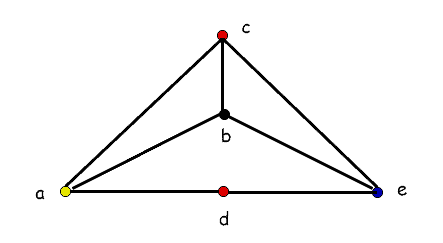1. 平面图简介
在本文中,我们将介绍平面图(Planar Graph)的基本概念及其关键性质。这类图结构在图论中非常重要,尤其在地图着色、电路布线等实际问题中具有广泛应用。
2. 平面图定义
平面图是指可以绘制在平面上,使得其边(edges)仅在端点处相交的图。 这种无交叉的绘制方式称为平面嵌入(planar embedding)或平面图表示(plane graph)。
注意区分两个概念:
- 平面图(Planar Graph):可以被绘制为平面嵌入的图,但当前可能不是无交叉的表示。
- 平面图表示(Plane Graph):已经绘制在平面上,且边之间没有交叉。
举个例子:

上图中:
是一个平面图,但不是平面图表示(因为边有交叉)。
是一个平面图表示(边无交叉)。
- 由于
与
同构(isomorphic),因此它是平面图。
2.1. 同构性(Isomorphism)
形式上:一个平面图与某个平面图表示是同构的。
两个图 和
同构,当且仅当存在一个一一映射
,使得:
例如:

这三个图彼此同构。左上角和下方的图使用恒等映射(即 ),右上角的图使用如下映射:
3. 平面图的性质
下面是一些平面图的重要特性。
3.1. 面(Faces)
在平面图中,图的边将平面划分为多个区域,这些区域称为面(faces)。每个面由图中的边和顶点构成其边界。
例如:

图中展示了三个面 、
和
,它们的度数(degree)均为 3。
此外,每个平面图都有一个外部面(exterior face),即无限大的区域。
3.2. 色数(Chromatic Number)
根据四色定理:
✅ 任何平面图的色数不超过 4。
也就是说,最多只需要四种颜色就可以给图的顶点着色,使得任意两个相邻顶点颜色不同。
例如:

该图的色数为 4。
3.3. 判断一个图是否为平面图
我们可以使用以下性质来判断一个图是否为平面图:
- 若一个连通平面图有
条边、
个面,则
- 若一个连通平面图有
个顶点、
条边、
个面,则
(欧拉公式)
- 若一个连通平面图有
个顶点、
条边,则
- 完全图
是平面图 ⇔
- 完全二分图
是平面图 ⇔
或
- 一个图是平面图 ⇔ 它不包含与
或
同胚的子图。
⚠️ 这些条件中,前三个只是必要条件,不能单独用于判断图是平面图。换句话说,满足这些条件的图可能是非平面图。
✅ 第六条是充分必要条件(Kuratowski 定理),是判断图是否为平面图的核心依据。
3.4. 非平面图(Non-Planar Graphs)
非平面图无法在平面上绘制而不出现边交叉。
两个经典的非平面图是:
- 完全图
- 完全二分图
例如:

这两个图是判断非平面图的基础,任何非平面图都包含与它们同胚的子图。
4. 小结
平面图是图论中的重要概念,其核心特征是可以在平面上无交叉地绘制。我们介绍了:
- 平面图和平面图表示的区别
- 同构性的定义
- 平面图的几个关键性质(如面、色数、欧拉公式等)
- 判断图是否为平面图的依据(特别是 Kuratowski 定理)
✅ 判断一个图是否为平面图的关键是:是否包含与 或
同胚的子图。
这为我们后续在算法设计、图绘制、地图着色等领域的应用打下了基础。